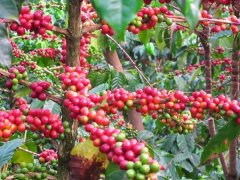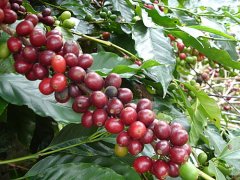The best way to hold Salvadoran coffee introduces The Best of El Salvador and COE

For professional baristas, please follow the coffee workshop (Wechat official account cafe_style)
El Salvador is arguably one of the most interesting producing areas, where the distribution and ranking of boutique coffee production has changed dramatically over the past decade. The traditional Santa Ana Manor has been recognized as the best producing area for several generations. in 2003, the first COE was held in El Salvador. Kilimanjaro Manor in Aida Batlle in Santa Ana region won the championship. "Baker" had multiple Aida Batlle on the shelf last year, baked by Cai Shimin, and the female owner was handled by a female bean baker and was warmly welcomed.
But in the next few years, as small farms joined the competition, the flavor of micro-batches and microprocessing plants became more and more recognized. in 2005, an unknown new producing area, Chalatenango, jumped to second place, breaking the eyeglasses of the public. Charat Nanguo is located in the north of El Salvador, close to the border of Honduras, local farmers grow Pacamara beans with outstanding flavor. In 2007, Charat Nango won the COE championship for the first time.
In terms of geological conditions, Charat Nango is very different from other producing areas, far from the volcanic zone off the coast of El Salvador, and most of El Salvador's coffee, including Santa Ana, comes from volcanic areas. In addition, the south fruit of Charat is located in the north, the temperature is colder, the fruit ripens slowly, and the sweetness is better. The COE championships in 2011, 2013, 2014 and 2015 were all won by farms in Charat Nanguo producing area. In last year's extraordinary Cup, Charat Nanguo won completely, and they were all responsible for the top three!
Unfortunately, this year's extraordinary Cup will not be held in El Salvador for various reasons. Project Origin has long worked closely with coffee farms in El Salvador, and after contact and discussion, decided to hold the The Best of El Salvador bid so that local coffee farmers, including Charatnango, can demonstrate the results of their bets on coffee cultivation.
The event is supported by several heavyweight landowners: Gilberto Baraona of Finca Los Pirineos, Jorge Raul Rivera of Santa Rosa, the champion of 2014 COE, and Mauricio Salaverria of Himalayas. Santa Rosa is located in Charat Nanguo. As for the Himalayan and Snowflake estates in Salaverria and the Pyrenees estate in Baraona, friends of Roasters should be impressed. They are all popular coffee on the shelves of Roasters.
The "Best Salvadoran Coffee" (The Best of El Salvador) will be conducted in this way:
In the week before the event, the registered farms will first go through the primary process, selected by the national judges of various countries, and select 35 coffees with a score of 84 +, which will then be tested by an international judge composed of Project Origin Best of Auciton.
On the last day of the event, bidding will be held for all coffee. People who are unable to participate in the event in person in the producing area can participate in the bidding through the Internet. After the bidding, Project Origin will assist the winning bidder in importing raw beans to various countries.
Project Origin's Best Salvadoran Coffee (The Best of El Salvador) is a non-profit event, and the farms invited to bid are the winners who have won the top 15 in the "extraordinary Cup" Cup of Excellence (CoE) in the past. The board members of Best Salvadoran Coffee include Sasa Sestic of Australia, Gilberto Baraona, Jorge Raul Rivera, and Mauricio Salaverria of El Salvador.
Important Notice :
前街咖啡 FrontStreet Coffee has moved to new addredd:
FrontStreet Coffee Address: 315,Donghua East Road,GuangZhou
Tel:020 38364473
- Prev

Salvadoran Coffee Creaman Manor description and brewing suggestions the ancient coffee producing areas of El Salvador
For professional baristas, please follow the coffee workshop (Wechat official account cafe_style) instructions and brewing suggestions: Kleiman Manor is located in the ancient coffee producing area of Santa Ana Volcano, this coffee estate, which has gone through three generations, only adopts a small but exquisite and ultra-high standard method of seed production, and then sells it to a small number of top buyers, so the quantity we have obtained is also wrong.
- Next

What style of Italian coffee beans is better to match? introduction to Inza washing method
Professional barista communication please follow the coffee workshop (Wechat official account cafe_style) Columbia coffee Cauca Inza washing method (Colombia Cauca Inza Washed) production area: Inza raw bean treatment: washing treatment coffee varieties: Bourbon, Caturra, Typica, Variedad Colombia appearance: .6dramp 300grgrM15 + screen
Related
- Detailed explanation of Jadeite planting Land in Panamanian Jadeite Manor introduction to the grading system of Jadeite competitive bidding, Red bid, Green bid and Rose Summer
- Story of Coffee planting in Brenka region of Costa Rica Stonehenge Manor anaerobic heavy honey treatment of flavor mouth
- What's on the barrel of Blue Mountain Coffee beans?
- Can American coffee also pull flowers? How to use hot American style to pull out a good-looking pattern?
- Can you make a cold extract with coffee beans? What is the right proportion for cold-extracted coffee formula?
- Indonesian PWN Gold Mandrine Coffee Origin Features Flavor How to Chong? Mandolin coffee is American.
- A brief introduction to the flavor characteristics of Brazilian yellow bourbon coffee beans
- What is the effect of different water quality on the flavor of cold-extracted coffee? What kind of water is best for brewing coffee?
- Why do you think of Rose Summer whenever you mention Panamanian coffee?
- Introduction to the characteristics of authentic blue mountain coffee bean producing areas? What is the CIB Coffee Authority in Jamaica?

